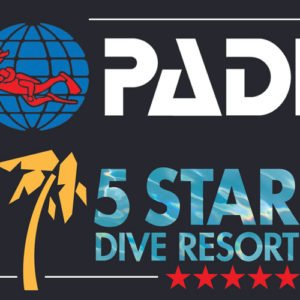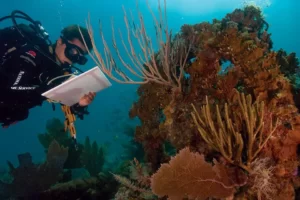Based in Kudat, Sabah, the Kudat Turtle Conservation Society (KTCS) is a non-profit organisation that…

Learn to dive in the Perhentian Islands, Malaysia
LEARN TO DIVE: Essential Steps for Beginner Scuba Divers
Are you ready to embark on an underwater adventure and become a certified scuba diver?
Our Perhentian Marine Research Station Project is a great opportunity to help the environment AND learn to scuba dive at the same time. Once certified, you will be part of a global community of eco-divers and you will be able continue your marine conservation journey anywhere in the world!
The PADI Open Water Diver course is the first step towards exploring the wonders of the underwater world, designed for beginners with no prior diving experience required. The Perhentian Marie Research Station has partnered with local PADI training centres on the island for you to learn to dive. By choosing PADI, the world’s largest and most widely recognized scuba diving training organization, you’ll be joining a community of over 900,000 divers who select PADI each year.
In this article, we’ll guide you through the essential steps of becoming a Certified Open Water Diver; including completing your knowledge development, confined water dives, and open water dives. Along the way, you’ll learn about the importance of marine conservation and the role you can play in protecting coral reefs and sea life as a responsible diver.
Get ready to dive into a world of adventure, discovery, and environmental stewardship!
Understanding PADI Open Water Certification
The PADI Open Water Diver course is designed to prepare you for real-world diving conditions, covering essential scuba diving skills, dive planning, use of dive tables & dive computers, and basic underwater navigation. This entry-level certification enables you to dive to a maximum depth of 18 meters/60 feet with a buddy, opening up a world of underwater exploration and adventure.
The course consists of THREE main phases:
- Knowledge Development: Learn the fundamentals of scuba diving through online OR in-person study materials.
- Confined Water Dives: Practice basic diving skills in a pool OR shallow water environment.
- Open Water Dives: Apply your skills in the open water over at least two days, completing four dives up to 18 meters/60 feet deep.
Upon completion, you’ll receive a digital certification card from PADI, the world’s largest and most widely recognized scuba diving training organization . This certification supports ocean protection and never expires, allowing you to dive into adventures across the globe while contributing to marine conservation efforts .
 Key Steps Before Starting Your Course
Key Steps Before Starting Your Course
When you learn to dive with the Open Water Diver course, you must meet the following requirements:
- Ensure you meet the age and physical requirements. The minimum age for the course is 10 years old, and it is available in multiple languages to accommodate diverse learners .
- You must be able to swim 200 meters/yards without stopping, float, and tread water for 10 minutes
- Additionally, you’ll need to complete a brief scuba medical questionnaire to ensure you’re physically fit for diving .
As you progress through your Open Water Diver course, you’ll learn about the importance of protecting coral reefs and sea life, becoming a responsible diver who can make a positive impact on the underwater world.
The Dive Center will provide you with all equipment required for your course. This includes:
PADI manual
Mask
Snorkel
Fins
Booties, if needed
BCD
Weight Belt
Wetsuit, if needed
Tank
Knowledge Development Phase
The Knowledge Development phase is one of the three main phases of the Open Water Diver Course, covering principles, concepts, terms, safety concepts, and risk management. This phase aims to prepare students for confined and open water dives, and can be completed in a matter of days or weeks . You have three options for completing the Knowledge Development phase :
- PADI Open Water Diver eLearning Offline: Ideal for tablet users, this option combines the “Open Water Diver Manual” and videos into one tool .
- PADI Open Water Diver eLearning Online: A browser-based online course for desktop computers with immediate feedback on answers and exam results .
- PADI Open Water Diver Manual and Video: An instructor-led learning option at a dive center using a book and DVD for classroom-based learning .
During this phase, you’ll learn scuba diving fundamentals, familiarize yourself with scuba equipment and terminology, and watch videos of diving skills . The Knowledge Development phase requires eight hours to complete . It can be completed in a classroom at the dive center or online before arriving at your diving destination through PADI e-Learning .
As you progress through the Knowledge Development phase, you’ll gain further detailed knowledge and practical skills, from equipment preparation and buoyancy control to dive planning and problem-solving . You’re not only learning essential diving skills but also becoming part of a community committed to marine conservation and protecting coral reefs. Reviewing home study materials and practicing skills and drills in the classroom and water will prepare you for the next phases of your Open Water Diver course .
Confined Water Dives
The Confined Water Dives phase is an essential part of your PADI Open Water Diver course, where you’ll practice basic diving skills in a pool OR pool-like environment under the guidance of your instructor 1. This phase is designed to build your confidence and familiarity with scuba equipment and techniques .
During the Confined Water Dives, you’ll learn and practice a variety of skills, including:
- Confined Water Dive :
- Dive equipment assembly & proper technique for putting on dive equipment
- Buddy check, BCD inflation/deflation at the surface, and regulator clearing
- Regulator removal & recovery, partially flooded mask, and alternate air source stationary for 30 seconds
- Controlled descent, maintaining buoyancy while swimming, air check, and proper ascent technique
- Inflating BCD at the surface, snorkeling, orally inflating the BCD, exiting the water, and disassembling dive equipment
- Confined Water Dive :
- Focuses on scuba mask skills to prepare for deeper water skills
- Designed to build confidence and familiarity with more advanced scuba skills, such as the PADI Mask Removal and Replacement skill
 Open Water Dives
Open Water Dives
The Open Water Dives phase is the final and most exciting part of your Open Water Diver certification, where you’ll apply your newly acquired skills in a real-world diving environment . This phase requires completing four open water dives, usually done over two days, in a body of water such as the ocean or a lake .
During your Open Water Dives, you will:
- Establish in-water comfort: Dives 1 and 2 focus on introducing you to the open water environment and helping you feel at ease underwater .
- Practice essential skills: Perform controlled descents, trim checks, clear partially flooded masks, and recover and clear regulators during dives 1 and 2 . In dive 3, you’ll learn to inflate your BCD orally to become neutrally buoyant and hover, and clear a fully flooded mask .
- Increase depth gradually: The maximum depth for dives 1 and 2 is 12 meters/40 feet, while dives 3 and 4 allow you to reach a maximum depth of 18 meters/60 feet .
- Complete dive-flexible skills: Any remaining skills not assessed during the first three dives will be completed during dive 4 .
Throughout the Open Water Dives, your instructor will assess your skills, which can be performed during any of the four dives . You’ll also learn how to assemble and use scuba gear, manage your buoyancy, respectfully approach marine life, and handle common problems .
At the completion of your open water training, you will be required to take a multiple choice, written test. Once you have passed this test you are officially an Open Water Diver!
Conclusion
Congratulations on completing your PADI Open Water Diver course! You’re now ready to explore the fascinating underwater world and join a global community of passionate divers. As you embark on your diving adventures, remember the importance of marine conservation and the role you can play in protecting the ocean’s delicate ecosystems.
Remember, by choosing environmentally responsible dive operators and practicing good buoyancy control, you can help safeguard coral reefs and the diverse marine life they support. As a certified diver, you have the opportunity to make a positive impact on the underwater environment while enjoying unforgettable experiences.
 Learn to dive in the Perhentian Islands and help us save marine life.
Learn to dive in the Perhentian Islands and help us save marine life.
Your Open Water certification is not just a personal achievement; it’s a gateway to a lifelong journey of discovery, adventure, and environmental stewardship. Let’s blow bubbles together!
FAQs
How should I prepare for my initial scuba dive in open water?
To prepare for your first open water dive, it’s advisable to practice in a swimming pool or a serene body of water. This helps ensure you’re comfortable and ready before venturing into the ocean. Also, read your PADI manual to become familiar with terms and concepts.
What advice is there for novice scuba divers?
Beginner scuba divers should remember to breathe continuously and never hold their breath. It’s also important to stay hydrated before and after diving to avoid dehydration. Divers should not overexert themselves after diving (ex. hiking) and must be aware of their personal limits, adhering to them for safety. As a general rule, after diving, you cannot fly for 24-hours.
What do you recommend I bring for my dive course?
- Swim suit
- Long or short sleeve sun shirt
- Towel
- Reef-Safe Sunscreen
- Sun Hat
- Dry Bag
- Reusable water bottle
How many dives are required to complete the PADI Open Water certification?
The PADI Open Water certification process includes four open water dives, which are typically conducted over the course of two days. These dives follow the confined water sessions and provide the opportunity to apply the skills you’ve learned in a controlled environment while exploring and enjoying the local aquatic life and scenery.






